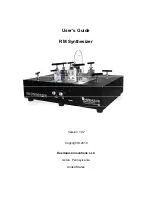
Attack
Operation Manual
8
Waldorf
Save the kit in the original host as a single Preset or Program. In VST hosts, those fi-
les typically have the suffix „fxp“, in AudioUnit hosts they are called „aupreset“.
Quit that host and start the other host that supports the corresponding plug-in for-
mat. Open an instance of the plug-in.
Select „Import File...“ in the „Edit“-menu of the plug-in editor.
Select the file to import from the Open dialog.
Confirm the selection with OK.
The Preset or Program is loaded and can be played as usual.
Selection of a Kit
To select a kit from a bank, please read the corresponding chapter in the manual of
your host software.
���
AudioUnits (Macintosh only) only support the first kit natively. The other kits of a
bank are stored and loaded anyway but you should avoid to use them because
AudioUnits don’t support anything like „Program Changes“.
Selection and Naming of Sounds
To select a sound from a kit, please proceed as follows:
Click on the Sound selector button on the left hand side of the plug-in.
You will hear the chosen sound. If you want to disable this, hold down the shift but-
ton on your computer keyboard while selecting the sound.
To (re-) name a sound, please proceed as follows:
Hold down the [Alt] key on your computer keyboard while selecting a sound. Now
you can enter a new name.
Playing the Attack Live
If you notice considerable latency times (delay) when you play the Attack via MIDI,
then the sound/audio card that you use and/or its driver is the source of the problem. If
the problem occurs within your system and recording by playing in real time is impor-
tant to you, then it is recommended that you replace your sound card and its driver
with a fast audio card and an ASIO driver (or CoreAudio driver for Mac OS X) that have
been optimized for the shortest possible latency time. When playing back Attack data
from a MIDI Track, latency does not occur.
The Solo Function of the Attack
With the Solo button in the upper left corner of the plug-in, you can listen to a
sound by itself. This is helpful if you want to listen to one particular sound
while triggering different sounds with the sequencer. All other sounds are muted when
this function is active. The Solo button lights up in red when the function is active. Of
course you can choose different sounds while soloing, and only the selected sound will
be heard. To deactivate the Solo function, simply click the button again.
Summary of Contents for Attack
Page 1: ......









































